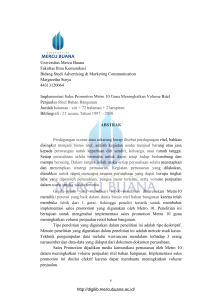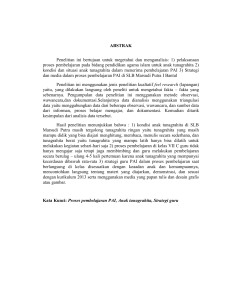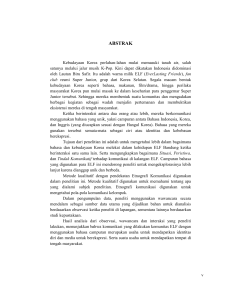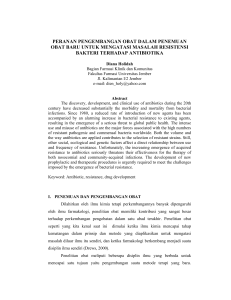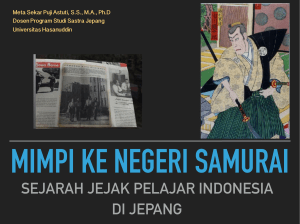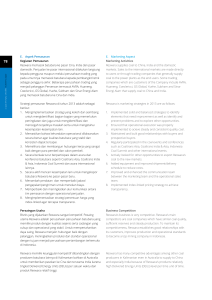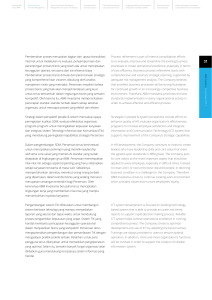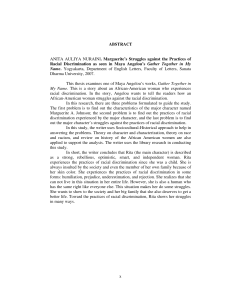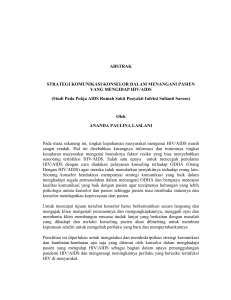Katak, Indikator Biologis Kerusakan Lingkungan Katak merupakan
advertisement
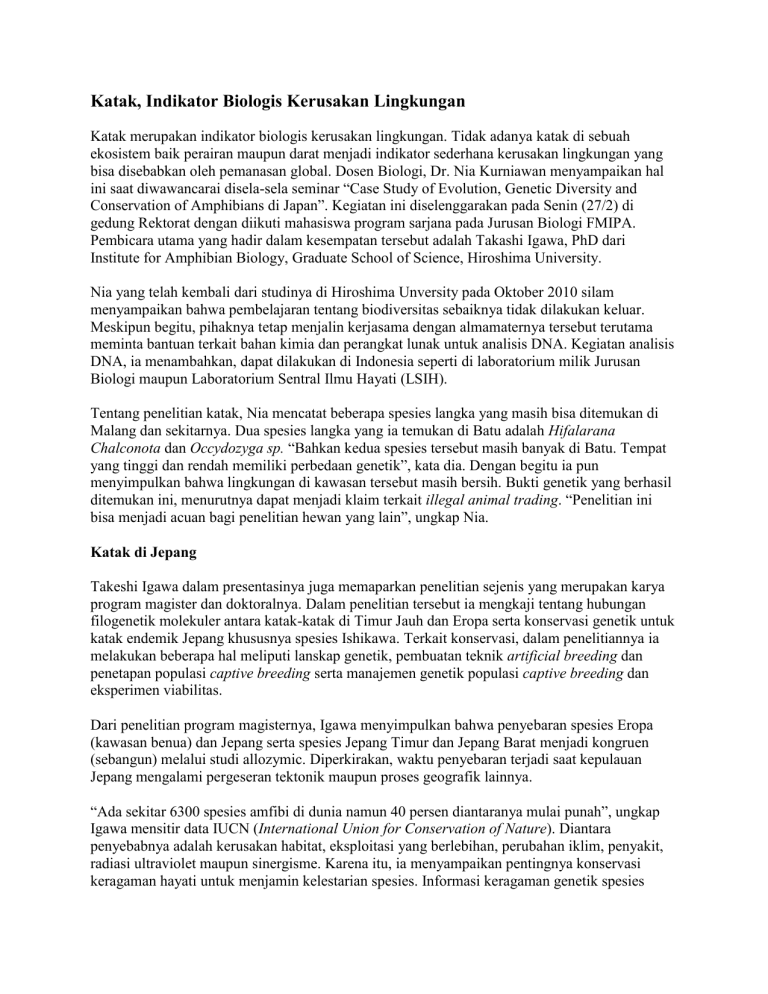
Katak, Indikator Biologis Kerusakan Lingkungan Katak merupakan indikator biologis kerusakan lingkungan. Tidak adanya katak di sebuah ekosistem baik perairan maupun darat menjadi indikator sederhana kerusakan lingkungan yang bisa disebabkan oleh pemanasan global. Dosen Biologi, Dr. Nia Kurniawan menyampaikan hal ini saat diwawancarai disela-sela seminar “Case Study of Evolution, Genetic Diversity and Conservation of Amphibians di Japan”. Kegiatan ini diselenggarakan pada Senin (27/2) di gedung Rektorat dengan diikuti mahasiswa program sarjana pada Jurusan Biologi FMIPA. Pembicara utama yang hadir dalam kesempatan tersebut adalah Takashi Igawa, PhD dari Institute for Amphibian Biology, Graduate School of Science, Hiroshima University. Nia yang telah kembali dari studinya di Hiroshima Unversity pada Oktober 2010 silam menyampaikan bahwa pembelajaran tentang biodiversitas sebaiknya tidak dilakukan keluar. Meskipun begitu, pihaknya tetap menjalin kerjasama dengan almamaternya tersebut terutama meminta bantuan terkait bahan kimia dan perangkat lunak untuk analisis DNA. Kegiatan analisis DNA, ia menambahkan, dapat dilakukan di Indonesia seperti di laboratorium milik Jurusan Biologi maupun Laboratorium Sentral Ilmu Hayati (LSIH). Tentang penelitian katak, Nia mencatat beberapa spesies langka yang masih bisa ditemukan di Malang dan sekitarnya. Dua spesies langka yang ia temukan di Batu adalah Hifalarana Chalconota dan Occydozyga sp. “Bahkan kedua spesies tersebut masih banyak di Batu. Tempat yang tinggi dan rendah memiliki perbedaan genetik”, kata dia. Dengan begitu ia pun menyimpulkan bahwa lingkungan di kawasan tersebut masih bersih. Bukti genetik yang berhasil ditemukan ini, menurutnya dapat menjadi klaim terkait illegal animal trading. “Penelitian ini bisa menjadi acuan bagi penelitian hewan yang lain”, ungkap Nia. Katak di Jepang Takeshi Igawa dalam presentasinya juga memaparkan penelitian sejenis yang merupakan karya program magister dan doktoralnya. Dalam penelitian tersebut ia mengkaji tentang hubungan filogenetik molekuler antara katak-katak di Timur Jauh dan Eropa serta konservasi genetik untuk katak endemik Jepang khususnya spesies Ishikawa. Terkait konservasi, dalam penelitiannya ia melakukan beberapa hal meliputi lanskap genetik, pembuatan teknik artificial breeding dan penetapan populasi captive breeding serta manajemen genetik populasi captive breeding dan eksperimen viabilitas. Dari penelitian program magisternya, Igawa menyimpulkan bahwa penyebaran spesies Eropa (kawasan benua) dan Jepang serta spesies Jepang Timur dan Jepang Barat menjadi kongruen (sebangun) melalui studi allozymic. Diperkirakan, waktu penyebaran terjadi saat kepulauan Jepang mengalami pergeseran tektonik maupun proses geografik lainnya. “Ada sekitar 6300 spesies amfibi di dunia namun 40 persen diantaranya mulai punah”, ungkap Igawa mensitir data IUCN (International Union for Conservation of Nature). Diantara penyebabnya adalah kerusakan habitat, eksploitasi yang berlebihan, perubahan iklim, penyakit, radiasi ultraviolet maupun sinergisme. Karena itu, ia menyampaikan pentingnya konservasi keragaman hayati untuk menjamin kelestarian spesies. Informasi keragaman genetik spesies yang terancam punah menurutnya penting untuk menetapkan strategi perlindungan dan pelestarian secara menyeluruh. Untuk konservasi jangka panjang ini, dalam penelitiannya ia menggunakan metode konservasi secara ex-situ. Dalam melakukan artificial breeding untuk O. ishikawae, ia menggunakan teknik inseminasi buatan menggunakan kelenjar bawah otak (pituitary) dari bullfrog. Dengan model ini, telur bisa dihasilkan pada suhu 18 derajat celcius, temperature air untuk embrio 18 derajat celcius, temperature air untuk larva 22 derajat celcius. Agar tumbuh dengan baik, larva diberi makan bayam yang direbus sementara katak dewasa diberi makan jangkrik. [nok] Frogs, as the Indicator of Damaging Environment Frogs are biological indicator of damaging environment. The disappearance of frogs in an ecosystem whether in territorial water or land can be caused by global warming. A biology lecturer, Dr. Nia Kurniawan stated this when he was interviewed in a seminar of “Case Study of Evolution, a Genetic Diversity and Conservation of Amphibians in Japan”. This seminar was held on Monday (27/2) in Rectorate Building and followed by undergraduate students of Biology FMIPA (Faculty of Mathematics and Natural Sciences). The main speaker who presented in this seminar was Takashi Igawa, PhD from Institute for Amphibian Biology, Graduate School of Science, Hirosima University. Nia who has returned from his study in Hiroshima University on October 2010 stated that the teaching of biodiversity should not be done outside. However, he stil conducts cooperation with his almamater especially to ask help related chemical materials and softwares to analyze DNA. The DNA analysis, he added, it can be done in Indonesia, such as, in the laboratory of Biology Department and Laboratory of Central Laboratory of Living Sciences (LSIH). Related to the research of frogs, Nia recorded some scarce species that still can be found in Malang and surrounding places. Two scarce species that he fund in Batu were Hifalarana Chalconota and Occydozyga sp. “Both species are commonly found in Batu. The higherst and lowest area have difference genetic, he said. Therefore, he can conclude that environment in that area is clean. The discovering of this genetic evidence, according to him, can be claimed to illegal animal trading. “This research becomes the reference for other animal researchers,” said Nia. Frogs in Japan In his presentation, Takeshi Igawa also presented similar studies which were the works of master and doctoral programs. In that study, he examined on the molecular phylogenetic relationships among frogs in Far East and Europe as well as genetic conservation to frog species endemic to Japan, especially Ishikawa. Related to conservation, in his research he was doing several things including genetic landscape, creation of artificial breeding techniques and the establishment of captive breeding populations and genetic management of captive breeding population and viability experiments. Of the research of master programs, Igawa concluded that the spread of European species (the continent) and Japan and Japanese species of East and West Japan became congruent (congruent) through allozymic studies. It is estimated, the deployment occured when the tectonic shift in the Japanese archipelago and other geographic processes. "There are about 6300 species of amphibians in the world but 40 percent of them become extinct," said Igawa to cite the data of IUCN (International Union for Conservation of Nature). Among the causes are habitat destruction, over-exploitation, climate change, disease, ultraviolet radiation and synergism. Therefore, he conveyed the importance of biodiversity conservation to ensure the preservation of species. Information of genetic diversity of endangered species is important to establish strategies according to the protection and preservation as a whole. For long-term conservation, in his research he used the method of ex-situ conservation. In carrying out artificial breeding for O. Ishikawae, he used the technique of artificial insemination using a gland under the brain (pituitary) from bullfrog. With this model, the eggs can be produced at a temperature of 18 degrees celsius, water temperature of 18 degrees celsius for embryonic, larval water temperature to 22 degrees celcius. In order to grow properly, the larvae are fed with boiled spinach while the adult frogs fed with crickets. [nok] translated by: A. Wicaksono
